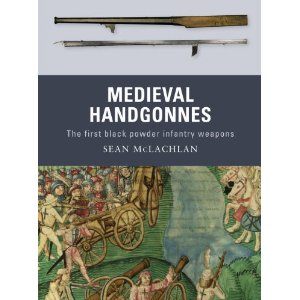
Sean McLachlan
Medieval Handgonnes:
The First Black Powder Infantry Weapons
Weapon 3 (Oxford: Osprey Publishing, 2010). 80pp. US $ 17.95/ UK £ 12.99/ CAN $ 19.95. ISBN 978-1-84908-155-9.
The third title of a new Osprey series, this book will not disappoint its readers. Perhaps experts in the field will find no new information on the subject, but non-specialists will enjoy a reliable work.
McLachlan uses the rather unusual word handgonnes, used in the 14th and 15th centuries to describe pre-matchlock, hand held black powder weapons, gonne being the Middle English term for gun. Invented in China in the 8th or 9th century, gunpowder appeared in Europe some centuries later and the first depiction of a black powder weapon is to be found in two codices, De Notabilibus Sapientiis et Prudentiis Regum and De Secretis Secretorum, dating to 1326. This kind of cannon was a vase-shaped gun, for which the word pot de fer was used. In the following decades artillery acquired an ever-increasing role. Larger guns were normally used only for sieges, being too cumbersome to be deployed in the field, while smaller pieces were used to defend fortified positions or in battle. In the meanwhile, the smallest pieces, handgonnes, proved more useful in the field. Cheap to make and simple to use, the handgonnes appeared early in the 14th century and spread quickly throughout Europe. Their success was partly due to the so-called ‘Infantry Revolution’ which took place in the 14th and the 15th century. Along with other infantrymen, handgonners needed little training and were far cheaper than mounted knights, even if their weapons were somewhat expensive and hard to keep resupplied with powder. Moreover, used in great numbers they could prove effective against the enemy. The Hussite Wars were one of the first tests of the effectiveness of the handgonnes on the battlefield. The defensive formation of circled wagons employed by the Hussites were manned by crossbowmen and hangonners who provided a continuous and [probably –ed.] devastating fire. Thanks to the Hussite Wars, handgonners enjoyed a significant increase in numbers and by the second half of the 15th century could be easily found in European armies. However, with the development of the matchlock arquebus in the late 15th and early 16th centuries, the pre-matchlock handgonne fell out of favor. Only the type often called hook-gun survived for a while, but basically the days of the handgonnes were over.
One of the main questions concerning handgonnes is how effective they were. Some modern experiments, though open to discussion, have shown that handgonnes suffered from a lack of accuracy and slow rate of fire. Perhaps the earliest pieces were more useful to intimidate rather than damage the enemy, though they became more effective as gunpowder and the weapon’s design improved. Still, at short range handgonnes had a superior power of penetration over longbows and crossbows.
McLachlan also provides technical information which scholars and re-enactors alike will find extremely useful. A four-page series of photos based on re-enactment experience shows the firing sequences of a hackbut and an arquebus. Of considerable value to the book are the good number of medieval illuminations, most of which from a Swiss chronicle kept in Berne, which offer some interesting examples of how hangonnes could be used on the battlefield.
McLachlan’s Medieval Handgonnes is an introduction of great value which helps the reader understand a sometimes difficult subject.
 Sergio Mantovani
Sergio Mantovani